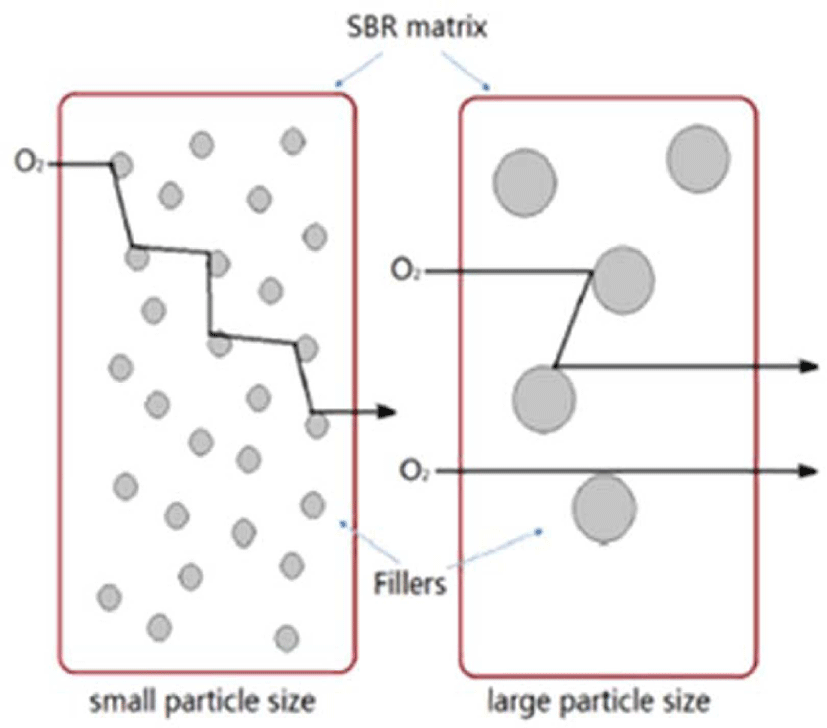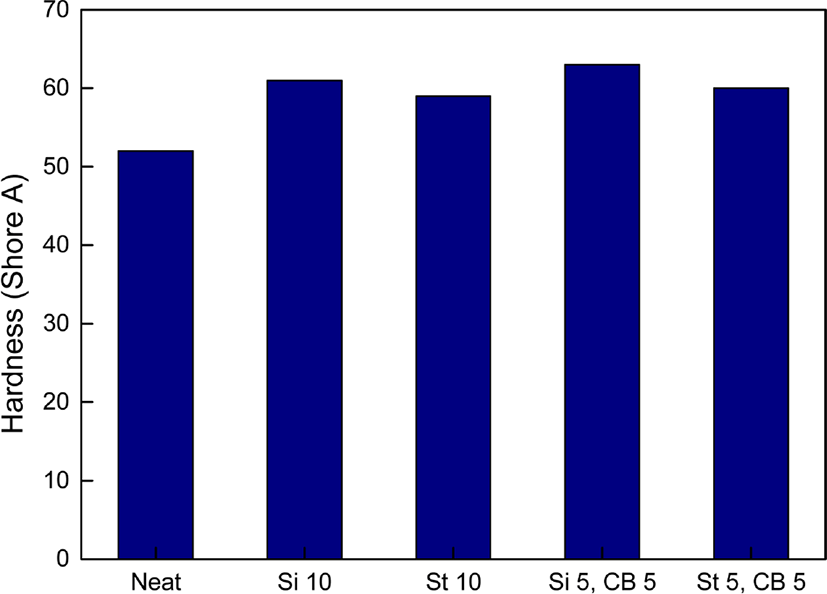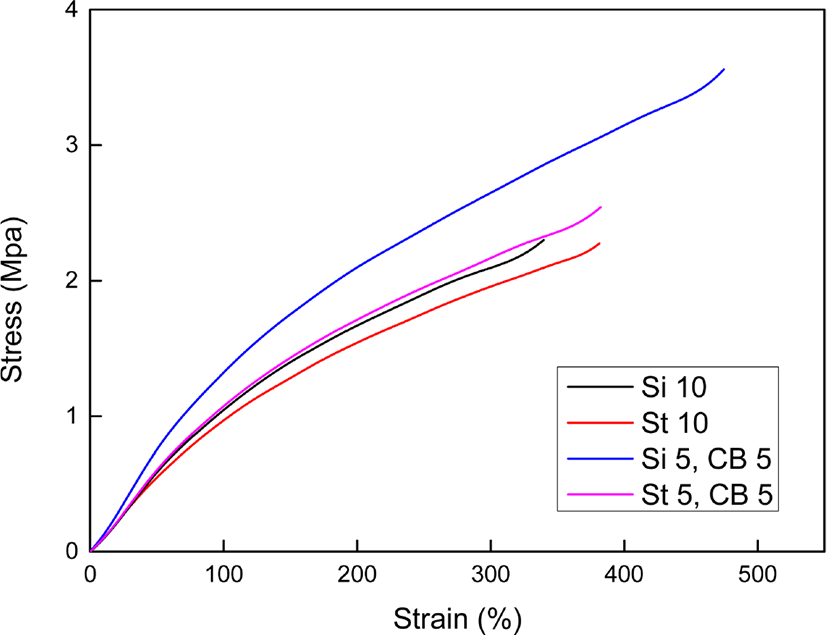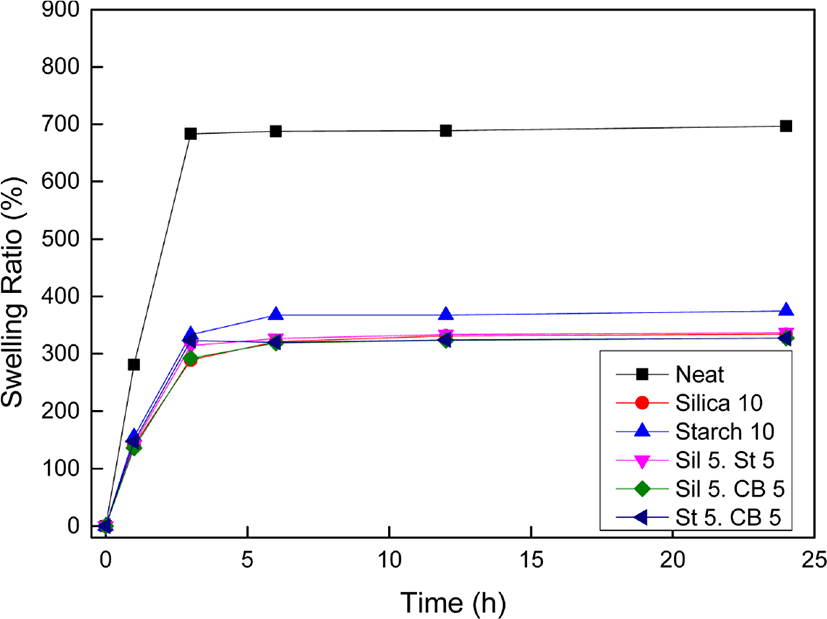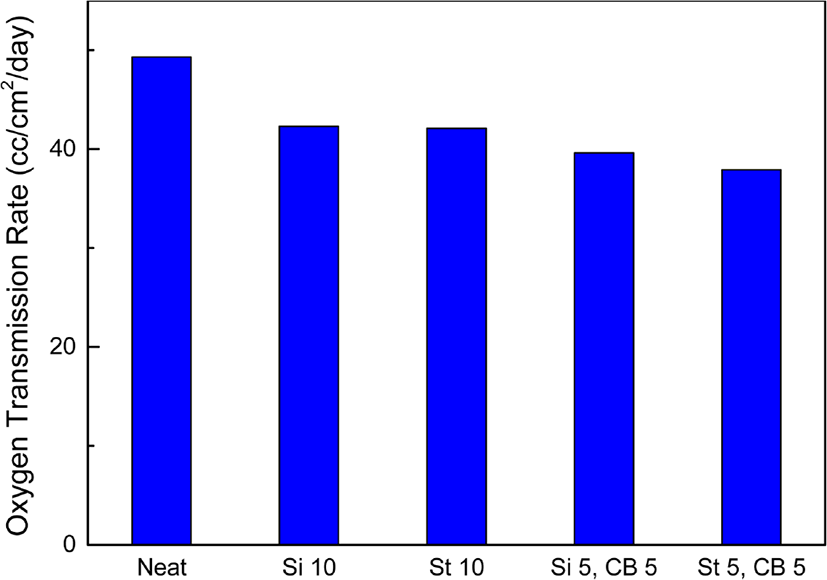Introduction
지난 150년 동안, 카본블랙은 고무의 보강제로서 사용되어 왔다. 하지만 카본블랙은 불완전 연소시켜 생긴 그을음을 모으거나, 그것들을 열분해하여 제조하고 있어 온실가스 배출 등의 환경오염 문제를 일으킨다. 최근 세계적으로 환경 문제의 관심이 높아지고 있으며, 카본블랙을 대체할 물질에 대한 연구가 증가하고 있다.1 실리카는 고무 제품의 정적 및 기계적 성질을 향상시키기 위하여 사용되는 무기 충전제이다. 실리카는 표면에 많은 실란올기(~Si-OH)기가 존재하여 극성의 성질을 갖는다. 이러한 성질은 실리카 입자 간에 수소결합을 형성하고 aggregate나 agglomerate인 이차구조를 형성한다. 고무 매트릭스 내에서 실리카 간의 응집력이 실리카와 고무의 친화력보다 크게 되어 분산력이 좋지 않고 고무 배합물의 성질이 좋지 않게 된다.2-4
Styrene-butadiene rubber (SBR)은 styrene과 butadiene을 중합하여 제조하는 대표적인 합성고무로 우수한 내마모성과 내노화성, 내열성을 요구하는 타이어, 신발 등 tread용 고무에 주로 사용되고 있다. SBR은 유화중합에 의하여 합성되는 유화중합 SBR (ESBR)과 음이온 리빙중합에 의하여 합성되는 용액중합 SBR (SSBR)이 있다. ESBR의 경우 고분자 주쇄에 가지가 많고, 유화중합 후 잔류하는 유화제 등으로 인하여 히스테리시스가 커지는데, Heinrich의 연구에서 SSBR은 실리카 표면의 미세 구멍에 잘 스며들어 고무-필러 간 상호 침투 작용이 커져서 고무 성능 면에서 히스테리시스도 줄어들고 낮은 회전 저항성과 우수한 젖은 노면 미끄럼 성을 가지는 균형 잡힌 특성을 가지는 것으로 보고되었다.5,6 하지만, SSBR은 비극성 고무로 실리카 표면의 실라놀 그룹의 강한 극성 때문에 배합에서 혼화성이 좋지 못하며 실리카-실리카 간의 상호작용이 강하여 분산성이 좋지 못한 단점이 있다.
본 연구에서는 SSBR의 실리카 분산성 향상과 물성 향상을 위한 방법으로 카본블랙을 실란 코팅 처리하여 첨가하였다. Vinyl triethoxy silane으로 표면 처리한 카본블랙의 첨가는 실리카와의 배합과정에서 분산성을 증대시키고 원료 고무와 실리카 간에 수소결합을 형성하게 되어 강한 상호작용을 가지게 된다.7-11,13-17 또한 실리카와 같이 강한 친수성을 가지고 있는 전분을 사용한 실험도 진행하였다. 고분자 물질인 전분은 커플링 에이전트가 사슬 내에서 가교제 역할을 하여 1 차적인 가교효과를 나타내 더 큰 보강효과를 가질 것으로 기대되었다.
본 연구는 최근 타이어에 많이 사용되는 실리카 보강 SSBR에 실란 코팅한 카본블랙을 첨가한 실험에 더하여 실리카를 대체하여 전분을 첨가한 실험을 진행하여 다양한 조성에서 가교특성, 인장특성, 모폴로지 관찰로 친수성 필러의 분산성에 관한 연구를 진행하였다.
Experimental
본 연구에서 사용한 원료 고무는 solution styrene-butadiene rubber (SSBR, Kumho Petrochemical, SOL-5270H, styrene content; 21 wt%, vinyl content; 65 wt%, Mooney viscosity (100°C); 63, Tg; −26°C) 를 사용하였고, 보강제로 실리카(Ultrasil 7000GR, Evonik Korea; BET 175 m2/g) 와 전분(Duksan Pure Chemical Co.), 카본블랙(N-550, Continental Carbon)은 vinyl triethoxy silane으로 코팅하여 사용하였다. 가교제로는 sulfur (Daejung Reagents Chemicals), 1, 2차 가교촉진제로는 N-cyclohexyl-2-benzothiazole sulfonamide (CBS, Tokyo Chemical Industry)와 2,2-dibenzothiazolyl disulfide (DD, Tokyo Chemical Industry)를 사용하였고, 이외에 zinc oxide (ZnO, Samchun Pure Chemical Co.), stearic acid (SA, Daejung Reagents Chemicals)를 사용하였다.
Silane coated carbon black (SC-CB)의 제조는 5 g 의 카본블랙을 H2SO4 200 ml 에 넣고 30°C 200 rpm에서 10 분간 분산시켰다. 그 이후에 vinyl triethoxy silane 10 g 을 첨가하여 30°C 600 rpm 으로 3 시간 동안 교반하였다. 교반하여 얻은 용액은 산 처리로 인하여 pH 가 낮은 상태인데, 원심 분리기를 이용하여 8000 rpm 으로 여러 번 증류수를 사용하여 희석시켰다. 최종 완성된 SC-CB는 2 일 동안 vacuum oven에서 60°C로 건조하여 사용하였다.
오픈 롤밀(open rollmill)에서 원료 고무에 가교제 및 가교촉진제를 제외한 약품을 배합한 후 CBS와 DD를 넣고 혼련하였다. 마지막으로 황을 넣고 배합고무를 제조하였다. Rubber process analyzer (RPA)를 이용하여 최적의 가황 시간(t90)을 측정하였고, 가황은 2 mm의 두께를 가지는 몰드에 160°C, 10 MPa 에서 진행하였다. 배합처방은 Table 1에 나타내 었다.
고무복합체의 모폴로지를 관찰하기 위해 제조된 고무복합체를 액체질소로 급속 냉동 후 파단면을 백금 코팅 후 scanning electron microscopy (SEM, EM-30, Coxem)을 이용하여 관찰하였다.
고무물성시험기(RPA-V1, U-CAN DYNATEX INC.)를 사용하여 160°C에서 측정하였다. 고무물성시험기의 데이터 값을 이용하여 최적의 고무복합체의 가교 시간을 결정하였다. 가교속도 CRI(Cure rate index)는 식 (1)로 계산하였다.
경도는 Shore A 경도계(Time, TH200)를 사용하여 총 5 개의 가황 고무를 6 mm 두께로 제작하여 5 번 측정한 후 최대 값 및 최소 값을 제외한 3 개의 시편의 평균을 구하였다.
인장강도는 만능재료시험기(H5KT-0401, Tinius Olsen)를 이용하여 측정하였다. 총 5 개의 아령형 시편을 제작하여 500 mm/min 의 crosshead speed로 측정하였고, 최대 값 및 최소 값을 제외한 나머지 값의 평균을 구하였다.
팽윤도 측정은 25 mm × 5 mm × 2 mm 의 가황 고무 시편을 톨루엔에 침윤시킨 후 30℃에서 1, 3, 6, 12, 24 시간이 되었을 때, 각 시료의 팽윤된 무게(W)와 팽윤 전 무게(W0), d1 (density of toluene), d2 (density of SSBR)을 측정하여, 식 (2)을 이용해 팽윤도를 계산하였다.
기체투과도 측정은 산소투과도측정기(OTR 8000, Ultra Tec Korea)를 이용하여 측정하였다. 고무복합체에서 필러는 기체의 투과를 방해하는데, 이는 필러의 크기가 작을수록, 분포가 균일할수록 더 커진다. 그 원리는 Figure 1에 나타내었다.
Results and Discussion
고무복합체의 모폴로지는 SEM을 통하여 관찰하였다. 일반적으로 SEM은 필러의 분산도를 보기 위해서 사용된다. Figure 2에서 Neat의 경우 비교적 매끄러운 표면을 가지고 있다. 실리카와 전분을 단독으로 사용한 시편에서 필러끼리 뭉침 현상으로 인한 큰 크기의 필러 입자들이 관찰되었다, SC-CB를 혼합하여 첨가해준 시편에서는 필러들의 크기가 작고 고르게 분산이 되어있는 것을 확인하였다.

Figure 3에서 열분해 온도의 차이는 크지 않았으나, 커플링 에이전트의 첨가에 따라 미세하게 증가하는 것을 확인하였다. 이는 커플링 에이전트의 첨가로 열 안정성이 향상된 것으로 볼 수 있다. 이런 열 안정성의 향상은 고무와 필러 간에 상호작용의 증대로 더 조밀한 매트릭스를 형성한 것으로 판단되었다.
Table 2에서 필러의 첨가로 고분자 사슬 내에 빈 공간을 채우게 되어 사슬의 움직임이 어렵게 되고 이는 MH의 증가의 원인이 된 것으로 보인다. 특히 이는 SC-CB를 첨가해준 시편에서 더 크게 증가하였는데, 이는 커플링 에이전트의 첨가로 필러 간의 조밀한 매트릭스를 형성하기 때문으로 생각된다. SC-CB를 첨가해준 시편에서 Ts2와 T90이 동시에 감소하는 것을 확인할 수 있다. 이는 필러 간의 하이브리드 형성으로 사슬 간 거리가 줄어 가교속도가 증가하는 것으로 판단되었다.
Figure 4에서 필러의 종류와 커플링 에이전트의 첨가를 달리한 각 조성의 경도 값을 나타내었다. 일반적으로 고무복합체의 기계적 물성은 가교도가 증가함에 따라 같이 증가한다. 실리카를 첨가한 시편이 전분을 첨가한 시편보다 필러 간 수소결합이 더 강하기 때문에 높은 경도 값을 나타내는 것으로 보인다. 커플링 에이전트를 첨가한 시편에서는 미첨가한 시편보다 더 조밀한 매트릭스를 형성하여 더 높은 경도 값을 나타냄을 확인하였다.
인장강도 또한 경도와 마찬가지로 가교도가 증가함에 따라 증가하는데, Figure 5에서 보여주는 결과와 같다. 고무시편의 파단은 고무와 필러 간 결합이 깨짐에 미치는 영향이 크다. 커플링 에이전트의 첨가로 고무와 필러의 결합이 강해지고 이는 인장강도의 증가로 나타났다.
고무복합체의 내용제성을 알아보기 위하여 톨루엔에 침윤시킨 후 무게 변화를 측정한 결과를 Figure 6에 나타내었다. 커플링 에이전트의 유무와 상관없이 기본적으로 실리카와 전분은 친수성이 강하여 팽윤도가 낮았다.
기체투과도 측정결과를 Figure 7에 나타내었다. 고무복합체의 기체투과도는 필러의 분산과 관계가 있는데, 작은 크기의 필러의 고른 분산은 기체가 시편 내에서 통과할 때의 경로를 길게하며 이는 낮은 투과성으로 나타난다. 커플링 에이전트를 첨가해준 시편에서 기체투과도의 감소를 볼 수 있다.
Conclusions
고무 매트릭스와 필러의 상호작용에서 분산성 향상과 물성 향상을 위한 방법으로 카본블랙에 실란 코팅을 하여 실험을 실시하였다. 실란 코팅된 카본블랙을 첨가한 조성에서 가교속도가 빨라지고 가교도가 증가하는 경향을 보였다. 이는 커플링 에이전트의 첨가로 더 조밀한 매트릭스를 형성한 것으로 판단되었다. 또한 조밀한 매트릭스의 형성은 고무복합체의 열분해 온도를 미세하게 증가시키는 것으로 확인되었다. 인장강도는 일반적으로 고무-필러 간 결합이 깨지며 일어나는데 실란 코팅된 카본블랙을 첨가한 조성에서 고무-필러 간 상호작용의 증대로 물성 향상을 보였고, 경도의 경우에도 실란 코팅된 카본블랙을 첨가한 조성에서 더 높은 값을 보였고, 인장강도와 경도 모두에서 실리카에 커플링 에이전트를 첨가했을 때 보강효과가 더 뛰어남을 보였다. 또한 고무-필러 간 상호작용 증대는 SEM 측정결과에서도 확인할 수 있었다. OTR 측정결과에서도 커플링 에이전트의 첨가는 고른 분포의 필러를 확인할 수 있었다. 특히 전분에서 기체투과도의 감소효과가 더 뛰어났다. 이는 사슬모양의 전분에서 1 차로 가교가 형성됨으로 더욱 조밀한 매트릭스가 형성됨으로 판단되었다. 팽윤도 측정결과는 실란 코팅된 카본블랙을 첨가한 조성에서 미세하게 우수하나 실리카와 전분 자체의 높은 친수성으로 인하여 보강 효과가 그리 크지 않았다.
